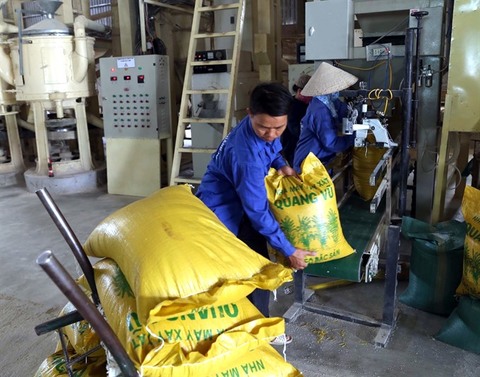
A worker moves rice bags at a private agricultural processing company in Phuoc Loc Commune, Tuy Phuoc District, Binh Dinh Province. — VNA/VNS Photo Vu Sinh
Viet Nam expects rice exports to regain strength by the end of the year after a brief lull, said Tran Van Cong, deputy director of the Agro Processing and Market Development Authority under the Ministry of Agriculture and Rural Development.
Over the first nine months of this year, Viet Nam shipped 4.9 million tonnes of rice abroad, earning US$2.5 billion, up 22 per cent from the same period last year.
Cong said that this is an impressive result, attributing the achievement to the effective rice sector restructuring programme which focuses on developing high-quality and fragrant rice to bolster exports to choosy markets.
Up to 80 per cent of exports now are classified as high-quality rice and sold at more than $500 per tonne, he said, adding that market diversification has been a catalyst for Vietnamese rice shipments.
China’s sudden imposition of a 50 per cent tariff on rice imports from July affected rice consumption in this market, especially sticky rice. At some points, Chinese traders paid only $380 per tonne for sticky rice, compared to the $530-540 per tonne at the beginning of the year. However, Vietnamese firms have worked to enhance rice exports to Iraq, the Philippines, Malaysia, the Ivory Coast and the United Arab Emirates (UAE).
The price of sticky rice has also increased from just below $400 per tonne in July and August, to $440 per tonne now. Furthermore, as local firms reduce export costs, Vietnamese rice will gain a competitive edge over that grown in India and Thailand, Cong noted.
In the coming time, purchase demand will is forecast to pick up in some countries, such as the Philippines, which will be needing to import an additional 500,000-800,000 tonnes of rice by the end of this year to refill exhausted reserves and stabilise the domestic rice price. Meanwhile, Indonesia and several African countries also hold great demand for rice imports in response to output decline due to floods and storms.
Besides, the Government’s new Decree 107/2018/ND-CP replacing Decree 109/2010/ND-CP, which takes effect from October 1, will remove difficulties and legal barriers for rice exporters to expand their foreign markets.
According to the decree, rice exporters will no longer be required to own rice storage, paddy milling and grinding facilities with processing capacities of 5,000 tonnes of rice. In addition, customs procedures will be simplified, creating favourable conditions for enterprises to export more to large consuming markets like China, Europe, Africa, Iraq, Cuba and the UAE.
Pham Minh Thien, general director of Co May Co Ltd, said many provisions on rice export have been modified to suit the development of enterprises. It has created more favourable conditions for businesses to enter the market and to reduce costs significantly.
The amendments to the Decree 109 which was issued eight years ago will promote businesses and farmers to put more investment in the production and trading of high-quality rice. Farmers are encouraged to supply high-value rice for rice exporters. — VNS